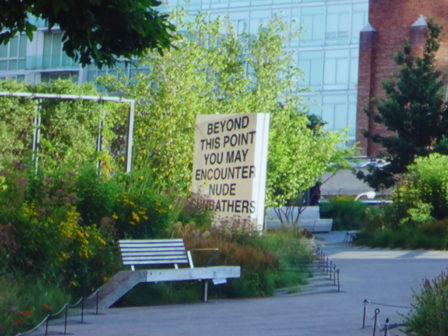New York Citys’ High Line Park

Signage on the High Line suggests nude sunbathing is allowed.
The first time I saw New York City’s High Line Park Gardens was January 1, 2015. At that time, it was still in the fetal stage of construction. However, when Rick Drake spoke about the Gardens of the High Line, I was amazed at the transformation and am aching to return. Drake gave us an overview of how the park came to be. It is, he said, an example of “elevating the nature of modern landscapes.”
My entire family is Manhattan based so New York City was home to me. When my family moved to the suburbs, riding the trains became part of the visit. This section of railroad was raised to give more space below. However, with the passage of time, the mile and a half stretch of rails was abandoned. Over time, debris and dirt composted creating a place for a weird wilderness of wildflowers and weeds to grow above the street.
When Robert Hammond first saw the High Line in 1999, he loved it. He and Joshua David founded Friends of the High Line to “share the magic” of its existance. Although they wanted to keep it intact, as it was when he saw it, bureaucracy prevented that. The structure needed remediation from reinforcing the structure, to lead removal and a drainage system. New Yorkers gave opinions on how the High Line should look; a major goal was to keep the naturalistic feeling of the original unplanned garden. This led to design competitions resulting in a concept that James Corner Field Operations, Diller Scofidio + Renfro and Piet Oudolf created.
Lisa Switkin was another landscape architect involved. The garden could neither be an exact replication of what had been growing nor an art museum on an industrial structure.” It is communal space going through a mile and a half of various lower West Side neighborhoods. The plants are mostly perennials. All were limited by the shallowness of the soil bed, meaning trees and plants needed to have spreading rather than deep roots. Piet Oudolf wanted the gardens to change with the seasons allowing new foliage to contrast against old or dried growth. The plants are largely drought tolerant, and they are eager to spread encompassing more than their originally allotted space.
The High Line is a study in contradictions: it embodies neighborhoods as well as industry, residences and factories, and the plants come from much of our indigenous prairie flora. The contrast between the gardens themselves and the surrounding cityscape creates an incredible experience. The Friends of the High Line staff and volunteers are committed to managing and maintaining landscapes. Piet Oudolf says “The one tool I can’t be without are my eyes. . .but when you are gardening, you really have to look.”
The gardens go from the Whitney Museum of American Art over Greenwich Village Chelsea, SoHo, up to the Rail Yards at West 34th Street. Each section is different and changes from day to day with the seasons.
One constant is the multi-trunked gray birch, a tree found all along the High Line. It is a small tree with fairly shallow roots. Its trunk is very white, and the tree is beautiful both with leaves and without.
Very little of the High Line has more than 18 inches of soil, and some areas have as little as 9 inches. A few areas, such as the Tiffany Overlook and the Flyover, have deeper bedding areas where planters have been installed or soil has been mounded. Many of the steel rails were replaced after the structure was repaired, and the wooden ties are now are spaced more widely to allow more plantings. As one moves north along the High Line, woody landscape opens to the Washington Grasslands. The grasslands team with grasses and flowers that appear wild. Those plants that thrive are encouraged; those that do not are replaced with species more responsive to the environment.
As one continues north along the High Line, there are places to sit, sculptures to admire and views to appreciate. The Sun deck and a water garden encourage children (and adults) to play.
A mile and a half of kaleidescoping beauty, no matter what the season greets you on this incredible structure. What a joy to be able to “hang out” at any time of the year.
The next Garden Club meeting will be held from 6 to 8 p.m. in March at the Mission Hills Nursery, located at 1525 Fort Stockton Drive. For information, visit www.missionhillsgardenclub.org.
Category: Life Style, National News







